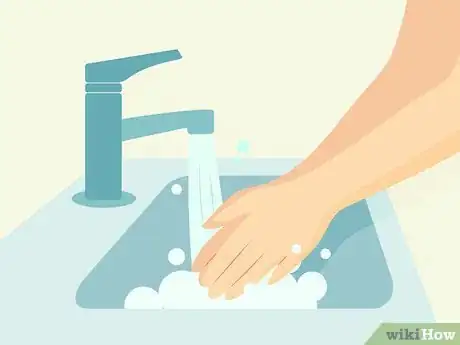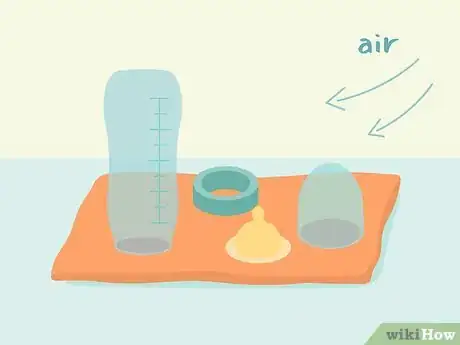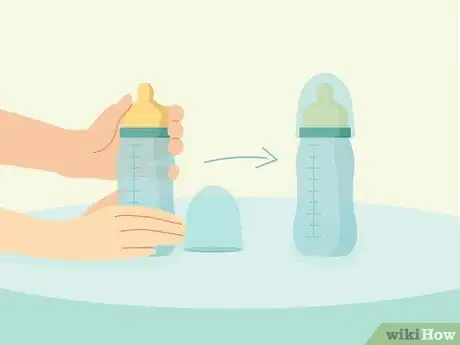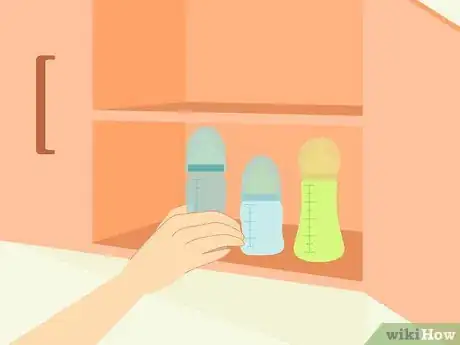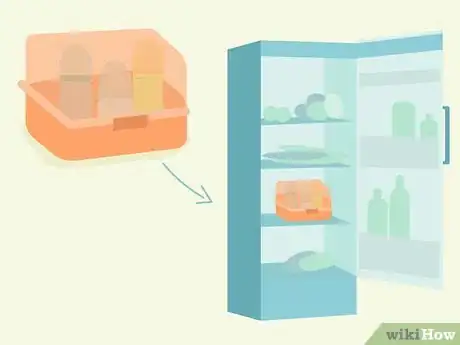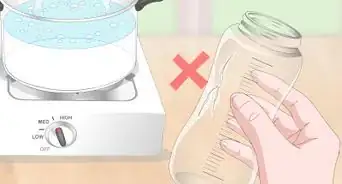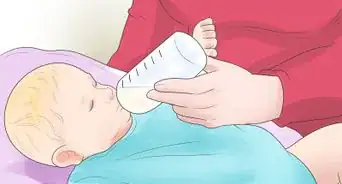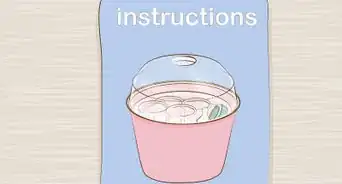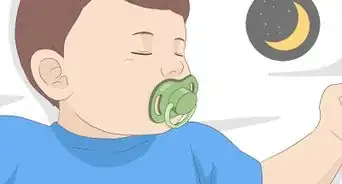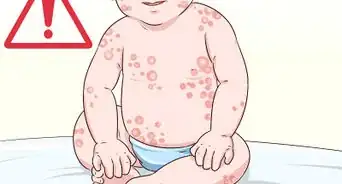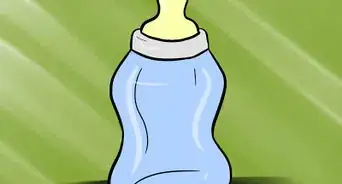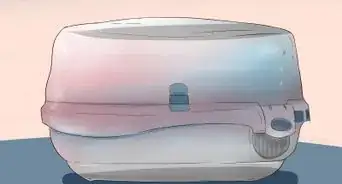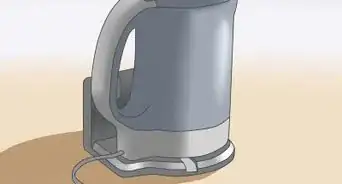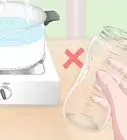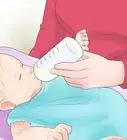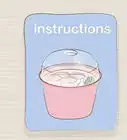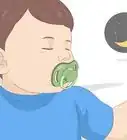This article was co-authored by Mor Levy Volner, IBCLC, RDN. Mor Levy Volner is an International Board Certified Lactation Consultant based in Southern California. She earned a BS in Clinical Nutrition from the University of California, Davis in 2009 and finished her Lactation Consultant course from the University of California, San Diego Extension Program in 2013, which included 300 hours of lactation consulting experience from Kaiser Permanente. She also has an MS in Dietetics/Nutrition from the California State University - Northridge in 2014.
This article has been viewed 77,592 times.
Sterlizing baby bottles removes germs and provides your baby with a safe, clean way to get the nutrition they need. While it’s generally recommended that you use them right after they’ve been sterilized, you can safely store baby bottles and keep them sterile for up to 24 hours in a clean cabinet, a sealed container in the refrigerator, or in a sterilizer.
Steps
Preparing to Store Sterile Baby Bottles
-
1Wash your hands before touching the sterile bottles. Use soap and water to wash your hands thoroughly before handling sterile baby bottles.[1] This will help prevent the transfer of bacteria or germs from your hands to the bottles.[2]
- If you want to use extra caution, you can handle the baby bottles with sterilized tongs instead of your washed hands.[3]
-
2Let the sterile bottles air dry completely on a clean dishcloth.[4] If you’re storing the baby bottles in a cabinet or container, remove them from the pot, sterilizer, or dishwasher you sterilized them in and place them on a clean dishcloth. Spread out the all the parts, including the nipple, attachment rings, and bottle, and let them air dry completely.[5]
- Air drying the sterilized bottle parts will help prevent germs and mold from growing in any crevices.
- If you’re storing the baby bottles inside the sterilizer, you can skip this step.
Advertisement -
3Reassemble the sterile baby bottles before storing them. Once the baby bottle parts are completely air dried, you can reassemble the bottles to make it easier to store them. If you prefer to store the parts separately, you can leave them disassembled and skip this step.[6]
-
4Sanitize the cabinet or container you plan to store the bottles in.[7] Before storing the sterilized baby bottles in a cabinet, make sure that you thoroughly clean the cabinets with sanitizing wipes or disinfecting soap and a clean cloth. If you’re storing the baby bottles in a container in the refrigerator, wash the containers with dish soap or run them through the dishwasher beforehand.[8]
- If you’re storing the baby bottles in the sterilizer, you can skip this step.
Keeping the Bottles Sterile
-
1Place the baby bottles in a clean kitchen cabinet. Once you’ve thoroughly cleaned a kitchen cabinet, you can safely store sterile baby bottles in it until you need to use them. Only store baby bottles in cabinets that have a door so you can ensure they will stay protected from bacteria and dust.[9]
- You can store the sterile baby bottles in a cabinet with dishes as long as the dishes have been thoroughly cleaned.
-
2Keep sterile bottles in a sealed container in the refrigerator. If you want to ensure that the bottles aren’t exposed to any germs or bacteria, you can store them in a sealed container, such as a plastic or glass food storage container, in the refrigerator. The cold temperature will help keep the bottles clean and keep any bacteria or mold from growing on them.[10]
- You can also store the bottles in an unused sealed plastic baggie.
-
3Leave the bottles in the sterilizer until you need to use them. If you used a tabletop equipment sterilizer to sterilize the baby bottles, you can leave the bottles in the sterilizer once the sterilization process has finished. While sterilizing the baby bottles, the sterilizer also sterilizes itself, making it a clean and safe place to store baby bottles until you need to use them or sterilize them again.
Expert Q&A
Did you know you can get expert answers for this article?
Unlock expert answers by supporting wikiHow
-
QuestionWhat mistakes can I avoid when sterilizing my baby's bottles?
 Mor Levy Volner, IBCLC, RDNMor Levy Volner is an International Board Certified Lactation Consultant based in Southern California. She earned a BS in Clinical Nutrition from the University of California, Davis in 2009 and finished her Lactation Consultant course from the University of California, San Diego Extension Program in 2013, which included 300 hours of lactation consulting experience from Kaiser Permanente. She also has an MS in Dietetics/Nutrition from the California State University - Northridge in 2014.
Mor Levy Volner, IBCLC, RDNMor Levy Volner is an International Board Certified Lactation Consultant based in Southern California. She earned a BS in Clinical Nutrition from the University of California, Davis in 2009 and finished her Lactation Consultant course from the University of California, San Diego Extension Program in 2013, which included 300 hours of lactation consulting experience from Kaiser Permanente. She also has an MS in Dietetics/Nutrition from the California State University - Northridge in 2014.
International Board Certified Lactation Consultant Make sure not to go to either side of the extremes, meaning you should avoid either cleaning your baby bottle too much and too little. If you're over boiling plastic or heating up the bottle too often, that could be a risk. You don't need to boil it for an hour, but you also should avoid not cleaning it all. You still want to make sure that it is cleaned adequately. Try learning balance and understand that these tasks don't need to correspond to any extremes. As new moms, you may get really anxious and feel like things must be done just right. Try to take a deep breath and realize everything is going to be okay.
Make sure not to go to either side of the extremes, meaning you should avoid either cleaning your baby bottle too much and too little. If you're over boiling plastic or heating up the bottle too often, that could be a risk. You don't need to boil it for an hour, but you also should avoid not cleaning it all. You still want to make sure that it is cleaned adequately. Try learning balance and understand that these tasks don't need to correspond to any extremes. As new moms, you may get really anxious and feel like things must be done just right. Try to take a deep breath and realize everything is going to be okay. -
QuestionWhat is the best way to sterilize a baby bottle?
 Mor Levy Volner, IBCLC, RDNMor Levy Volner is an International Board Certified Lactation Consultant based in Southern California. She earned a BS in Clinical Nutrition from the University of California, Davis in 2009 and finished her Lactation Consultant course from the University of California, San Diego Extension Program in 2013, which included 300 hours of lactation consulting experience from Kaiser Permanente. She also has an MS in Dietetics/Nutrition from the California State University - Northridge in 2014.
Mor Levy Volner, IBCLC, RDNMor Levy Volner is an International Board Certified Lactation Consultant based in Southern California. She earned a BS in Clinical Nutrition from the University of California, Davis in 2009 and finished her Lactation Consultant course from the University of California, San Diego Extension Program in 2013, which included 300 hours of lactation consulting experience from Kaiser Permanente. She also has an MS in Dietetics/Nutrition from the California State University - Northridge in 2014.
International Board Certified Lactation Consultant
References
- ↑ Mor Levy Volner, IBCLC, RDN. International Board Certified Lactation Consultant. Expert Interview. 5 May 2020.
- ↑ https://www.cdc.gov/healthywater/hygiene/healthychildcare/infantfeeding/cleansanitize.html
- ↑ https://www.nhs.uk/conditions/pregnancy-and-baby/sterilising-bottles/
- ↑ Mor Levy Volner, IBCLC, RDN. International Board Certified Lactation Consultant. Expert Interview. 5 May 2020.
- ↑ https://www.cdc.gov/healthywater/hygiene/healthychildcare/infantfeeding/cleansanitize.html
- ↑ https://www.nhs.uk/conditions/pregnancy-and-baby/sterilising-bottles/
- ↑ Mor Levy Volner, IBCLC, RDN. International Board Certified Lactation Consultant. Expert Interview. 5 May 2020.
- ↑ https://www.cdc.gov/healthywater/hygiene/healthychildcare/infantfeeding/cleansanitize.html
- ↑ https://www.cdc.gov/healthywater/hygiene/healthychildcare/infantfeeding/cleansanitize.html
- ↑ https://raisingchildren.net.au/newborns/breastfeeding-bottle-feeding/bottle-feeding/bottle-feeding-equipment
- ↑ https://www.babycentre.co.uk/a554982/sterilising-bottle-feeding-equipment
- ↑ https://www.nhs.uk/conditions/pregnancy-and-baby/sterilising-bottles/
- ↑ https://raisingchildren.net.au/newborns/breastfeeding-bottle-feeding/bottle-feeding/bottle-feeding-equipment
- ↑ https://raisingchildren.net.au/newborns/breastfeeding-bottle-feeding/bottle-feeding/bottle-feeding-equipment
